A water right is a legal authorization for a person to divert and put to "beneficial use" water from a water source, such as a stream, pond, lake, or aquifer. The National Park Service secures water rights as necessary to provide water for staff and visitors and to protect water-related resources in parks.
Water for Beneficial Use

NPS/Beane
Beneficial uses of water include domestic use, irrigation, stock-watering, manufacturing, mining, hydropower, municipal use, aquaculture, recreation, fish and wildlife, and instream flow. A water right authorizes a person to put a certain amount of water to one of these beneficial uses.
The National Park Service needs to secure water rights in some places to assure that visitors can enjoy the water in parks and to protect critical habitats. In general, water rights are administered by state agencies, and conflicts over water rights are determined by state agency hearings or state court proceedings.
Water Rights Doctrines

NPS/Seavey
There are two water law doctrines followed in the United States. The riparian doctrine was derived from English common law and is predominately used in the eastern United States. The prior appropriation doctrine was developed in California and Colorado and is predominately used in the western States. Each state has its own variation of the two basic principles, and some states use elements from both doctrines.
Riparian Water Rights
Under the riparian doctrine, a landowner whose property adjoins or contains a water source has the right to make reasonable use of water from that source. Reasonable use means that each riparian owner can divert and usesurface water so long as that use does not excessively diminish the quality or quantity of the water that is available to other riparian owners. In theory, water surpluses and shortages on a source are to be shared equally among all riparian right holders. Water generally must be used on the riparian parcel and cannot be transferred out of the watershed.
As a land owner, Lassen Volcanic National Park diverts water using riparian rights in support of visitor and staff uses, like the water that is used at the park visitor center.
Prior Appropriation Water Rights
In general, a prior appropriation water right is established by obtaining a water right permit from a state. The water right is completed by putting water to beneficial use according to permit. Under the prior appropriation doctrine, water rights are "first in time, first in right". When the quantity of water available is insufficient to meet the needs of all water right holders, the senior water right holders may divert water, and junior water right holders may not. The concept of "priority date" is important. It is generally associated with the date that water was first put to beneficial use, or the date that a successful application for a water right was submitted. It indicates the seniority among competing users. If a water right is not used for a certain length of time, it may be considered abandoned or forfeited.
Water rights can be used to help protect water-dependent resources, and not just consumptive uses like drinking water or irrigation. Point Reyes National Seashore holds rights that protect stream flows in support of fish, wildlife, and other riparian values.
Groundwater
Groundwater is increasingly important as a water source in much of the United States. Like surface water, use of groundwater is generally governed by state law. In some states, groundwater and surface water are administered as one resource, and in other states, they are administered separately. Depending on the state, the right to use groundwater may be based on land ownership, much akin to a riparian right; or the right may be based on compliance with state statute, much akin to a prior appropriation right.
National parks use groundwater in many instances to support visitor and staff water uses. In addition, groundwater levels may be important to water-related resources in a park. In either instance, a park will secure the necessary rights to support such needs and uses, either through the state law system or through a federal reserved right, discussed below.
Federal Reserved Water Right

NPS/Frederick
This type of water right is established when the federal government reserves land for a specific federal purpose like an Indian reservation, national park, national wildlife refuge, national forest, or military base. Courts have held that there is an implied water right to satisfy the primary purposes of the reservation, even though the proclamation or legislation establishing the reservation does not mention water. This type of right cannot be lost through non-use. The existence and nature of such rights are generally determined through administrative or court proceedings.
At Great Sand Dunes National Park, Medano Creek presents a unique attribute—a pulsing stream flow that reflects the interplay of surface water, groundwater, and the dunes. This attribute is protected by a federal reserved right for surface water and state law-based rights for groundwater.
Last updated: January 15, 2016
